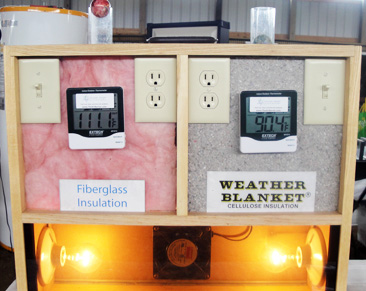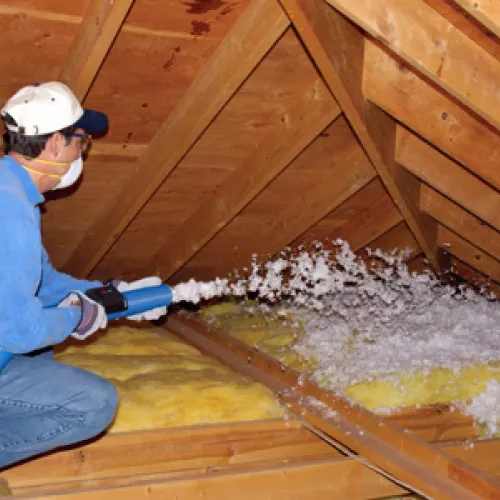Making sure your home has adequate insulation in walls and attics, as well as being air-sealed, is a great way to reduce energy use and save money in the long run.
What is air sealing? Air sealing is filling holes, cracks, and gaps in the air barrier between the interior and exterior of your home.
What is an air barrier? An air barrier is anything that prevents air from flowing from indoors to outdoors, or vice versa.
Should you insulate or air seal first? Ideally, air sealing should be done first. Holes in your air barrier allow air to escape no matter how much insulation you have. Air sealing works to keep air you have paid to heat or cool within your home.
How to you test for air tightness? One of the most common ways to test air tightness is through a blower door (a large fan that blows air out of your house while measuring the pressure within).
 What are the different insulation options? There are two main insulation choices: Fiberglass (generally large pink batts) or Cellulose (looks like dirty snow that is sprayed when installed). So which one is best? It depends on your home’s structure. For areas that are curved, irregular shaped, or have poor air sealing, cellulose is probably a better choice. Because there are no seams, like with the batts, the cellulose creates a seamless blanket that locks in place. In the photo to the left, you can see a demonstration of the differences between fiberglass and cellulose insulation. In the bottom of the glass-plated box are incandescent light bulbs that are emitting heat and a fan to push air. The wood divider above the bulbs has been perforated so that air can potentially move into the insulated space. At the top of the box there is a vent tube with a ball in it. On the left you can clearly see that the temperature is much higher and the ball is raised—meaning that hot air produced by the bulbs is flowing freely through the area. Meanwhile, on the right, the temperature is lower and the ball is resting on the vent—meaning the hot air is not allowed to flow through the space. (photo of model built by Champion Insulation taken at the A-A Exteriors booth at the 2013 MREA Energy Fair)
What are the different insulation options? There are two main insulation choices: Fiberglass (generally large pink batts) or Cellulose (looks like dirty snow that is sprayed when installed). So which one is best? It depends on your home’s structure. For areas that are curved, irregular shaped, or have poor air sealing, cellulose is probably a better choice. Because there are no seams, like with the batts, the cellulose creates a seamless blanket that locks in place. In the photo to the left, you can see a demonstration of the differences between fiberglass and cellulose insulation. In the bottom of the glass-plated box are incandescent light bulbs that are emitting heat and a fan to push air. The wood divider above the bulbs has been perforated so that air can potentially move into the insulated space. At the top of the box there is a vent tube with a ball in it. On the left you can clearly see that the temperature is much higher and the ball is raised—meaning that hot air produced by the bulbs is flowing freely through the area. Meanwhile, on the right, the temperature is lower and the ball is resting on the vent—meaning the hot air is not allowed to flow through the space. (photo of model built by Champion Insulation taken at the A-A Exteriors booth at the 2013 MREA Energy Fair)
What are other benefits of cellulose? Although benefits vary with different brands, most cellulose installers boast: improved noise control, better fire resistance, more environmentally friendly (generally composed of recycled materials), more health-friendly (does not contain urethane, formaldehyde or asbestos), and mold and rodent resistance.
How do I choose a contractor? Minnesota Energy Resources suggests that you get more than one bid so that you have a basis for comparison. Furthermore, using a Minnesota Energy Resources Authorized Insulation Contractor is a safe bet for quality assurance. If you are not served by Minnesota Energy Resources, ask your utility and/or your energy auditor about companies they recommend.
Do rebates exist for this work? Minnesota Energy Resources offers rebates to homeowners looking to do air sealing or insulation upgrades. Only existing homes are eligible. New homes are not eligible (defined as built in the last 2 years). Other utilities across the state also offer rebates—be sure to ask your utility to see what assistance they can provide.
Get more information: Visit the Minnesota Energy Resources website or see all utility program links on the DSIRE website. You can also read our companion blog post, How much insulation do I need in my attic?
Looking for more educational resources? See the Building Envelope links from the Minnesota Department of Commerce, Division of Energy Resources.


